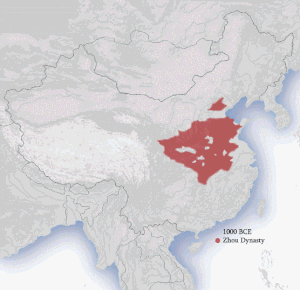User:Inductiveload/Portal:History of China
Documents and texts relating to the history of China. Extending over 4000 years, recorded Chinese history includes dozens of kingdoms and Imperial dynasties. More recently, the 20th century saw the end of the Imperial government, involvement in the World Wars and the establishment of the current People's Republic of China.

General Chinese history
[edit]- A Sketch of Chinese History, by Francis Lister Hawks Pott (1908) (external scan)
Ancient China
[edit]Xia dynasty (c. 2070–1600 BC)
[edit]
Previously transliterated Hsia. With no known contemporaneous written records (the first known Chinese script, oracle bone script, had not yet emerged), the Xia dynasty is recorded mostly retrospectively though the early Chinese classics.
Shang dynasty (c. 1600–1046 BC)
[edit]
Also called the Yin dynasty, the bronze-age Shang dynasty is mostly represented by bronzes and carvings, as well a being described in a few of the Chinese classics.
- A Dissertation on the Ancient Chinese Vases of the Shang Dynasty from 1743 to 1496 B. C., by Peter Perring Thoms (1851) (external scan)
- Archaic Chinese Bronzes of the Shang, Chou and Han Periods in the Collection of Mr. Parish-Watson, with notes by Berthold Laufer (1922) (external scan)
Zhou dynasty (c. 1046–256 BC)
[edit]
Previously transliterated as Chou. Divided into the "Western" and "Eastern" dynasties, with Eastern Zhou further divided into the "Spring and Autumn" period, followed by the fractured "Warring States" period. The Chinese script evolved into a form very similar to the modern form during this time. The foundations of Chinese philosophy (both Confucianism and Taosim) were laid during the Zhou dynasty, containing as it did Confucius, Laozi, Mencius and Mozi, amongst others.
- The Ancient History of China to the End of the Chou Dynasty, by Friedrich Hirth (1908) (external scan)
- Portal:Chinese classics—many of the Classics date from this period
Imperial China
[edit]Following the unification of China by Qin Shi Huang, marking the end of the Warring States period, the short Qin dynasty was the first Imperial dynasty. The major dynasties of Imperial China were sometimes punctuated by several periods of fracturing into smaller states before reunifying under later dynasties.
Qin dynasty (221–206 BC)
[edit]
Previously transliterated Ts'in. The first dynasty of unified China, the Qin dynasty was also the period of the "burning of books" when many records from the pre-Qin era were destroyed or lost.
- Qin Shi Huang—the first emperor of the dynasty and of a unified China
- "The First Emperor" in Leaves from my Chinese Scrapbook, by Frederic Henry Balfour (1887)
Han dynasty (206 BC–220 AD)
[edit]
Lasting over four centuries, the Han period is considered a golden age in Chinese history.
- Emperor Gaozu of Han—founded the dynasty
Six Dynasties (220–589)
[edit]
A collective term for the periods of the "Three Kingdoms" (Wei, Shu and Wu), the Jin dynasty (265–420) and the Northern and Southern Dynasties (420–589). Although a period of instability and war, it was an important period for poetry.
- Setting of the Romance of the Three Kingdoms, which was written later, in the Ming dynasty.
Sui dynasty (581–618)
[edit]
A short-lived dynasty which was important for the reunification of China after the fractured Six Dynasties period and for the spread of Buddhism within China.
Tang dynasty (618–907)
[edit]
Regarded as a golden age of Chinese literature and art, the Tang dynasty produced over 49,000 poems that survive to the present. Also written were many encyclopaedic and historiographical works, as short stories and travel writings.
- The Founding of the T'ang Dynasty (1941) by Woodbridge Bingham (external scan)
Liao dynasty (907–1125)
[edit]
The Liao dynasty controlled regions of northern China, Mongolia, the Russian Far East and northern Korea.
Song dynasty (960–1279)
[edit]
Previously transliterated Sung. Coinciding with the Liao dynasty in the north, and Western Xia in the north west, the 300 year Song dynasty was notable for technological improvements, such as the invention of movable type, banknotes, a standing navy, gunpowder and compasses.
- Su Shi—famed poet and writer of the Song dynasty
Yuan dynasty (1271–1368)
[edit]
Founded by Mongols from northern China, the Yuan dynasty marked an increase in the use of Vernacular Chinese and movable type, and so saw a large increase in the number of printed texts.
- Kublai Khan—founder of the Yuan dynasty
Ming dynasty (1368–1644)
[edit]
Lasting 276 years, the Ming dynasty is notable for the flourishing of culture, including literature, poetry, music and art. The vernacular novel became popular, along with travelogues, which expanded audiences to those unable to understand Classical Chinese.
- Romance of the Three Kingdoms written by Luo Guanzhong (14th century)
Qing dynasty (1644–1912)
[edit]
The last imperial dynasty of China, the Qing dynasty was headed by the Manchu people. The Qing dynasty also marked the start of conflicts with Western power, which expanded their empires, religions and maritime trades during the same time.
- Cixi—empress dowager generally credited with ruling the country at the end of the dynasty
- Guangxu–penultimate emperor of China.
- Great Qing Legal Code—the legal code of the Qing dynasty (external scan)
Modern China
[edit]Republic of China (1912–1949)
[edit]
The Republic of China was established following the overthrow of the Qing dynasty. During this time, many wars were fought internally and externally. China was invaded by Japan in 1937 and was occupied until the end of World War II.
- Sun Yat-sen—provisional president in 1912. Leader of the Guomindang party 1919–1925.
People's Republic of China (1949–present)
[edit]
Following the Chinese Communist Revolution in 1949, the nationalist government retreated to Taiwan, which remains the Republic of China. China become a communist state and remains governed by the Communist Party of China to this day.
- Mao Zedong—chairman of the CCP, 1949–1976
- Deng Xiaoping—paramount leader of China from 1978–1989
